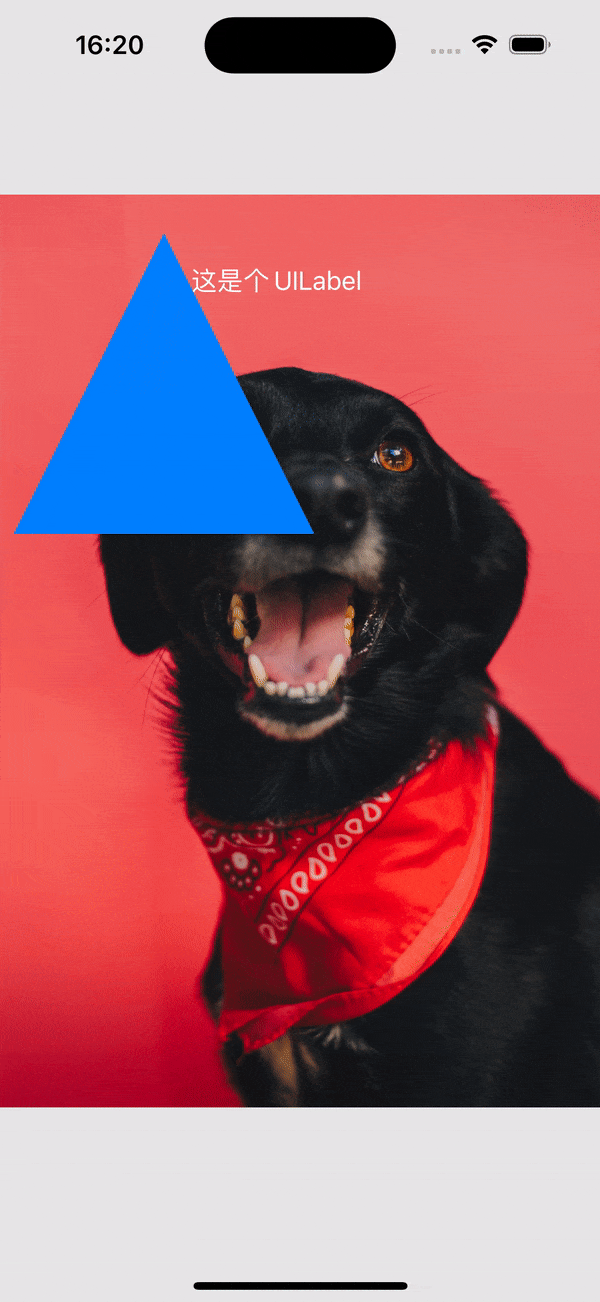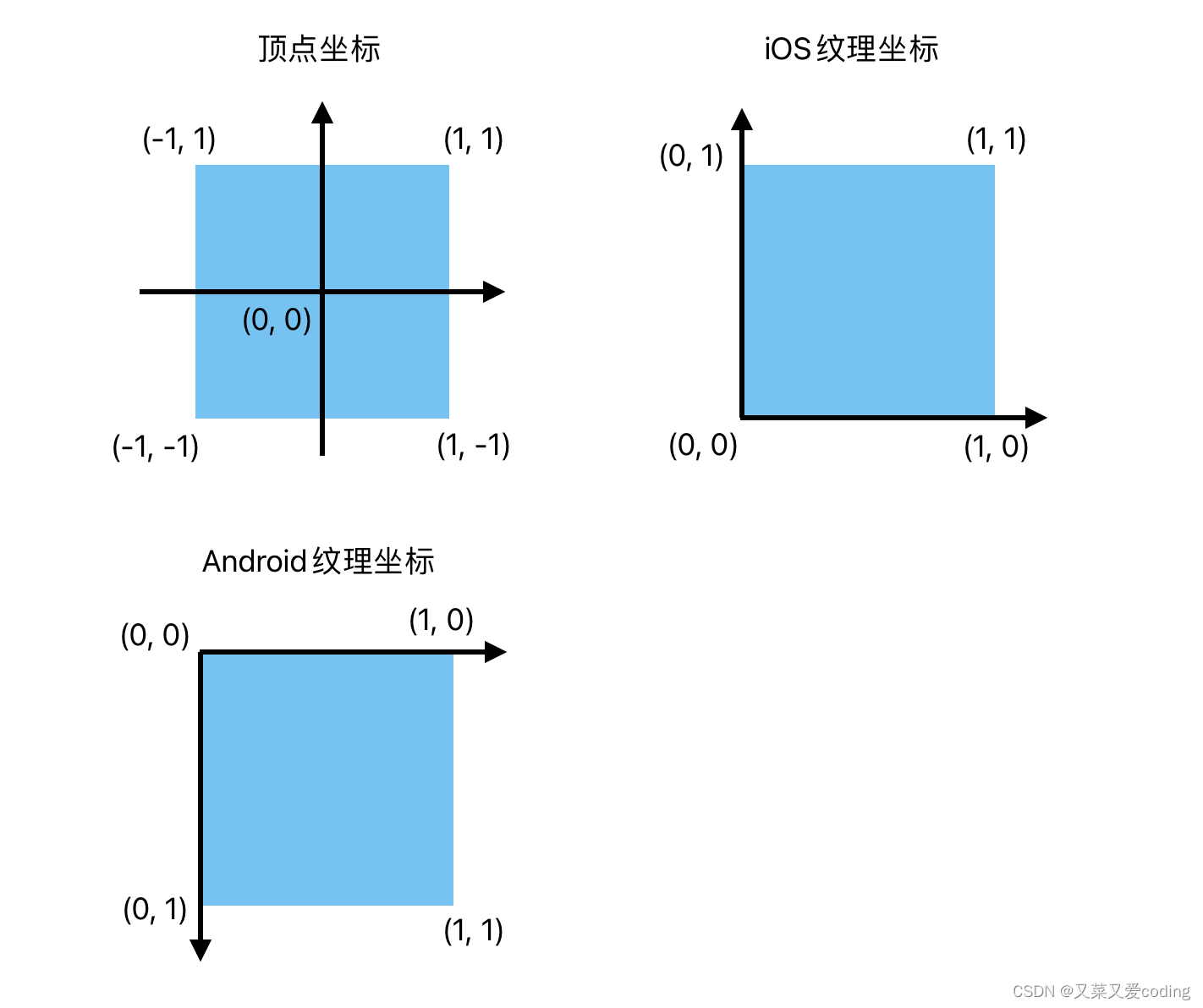objective-c-iOS OpenGL ES3.0入门实践
推荐 原创一、效果图
入门实践,做的东西比较简单,效果如下:

二、关于顶点坐标和纹理坐标
绘制图片需要设置顶点坐标和纹理坐标并加载像素数据,之所以要指定两组坐标是因为纹理和顶点使用不同的坐标系,就是告诉OpenGL:把图像的某一区域绘制到屏幕的某一区域,3个点能确定一个三角形区域,我们把一张图分成4个三角形,分别是中心点和每条边点两个顶点组成的三角形,如下图,它图能够帮助你理解后面代码 GLImage.m 中的两组顶点为什么是那样子设置的

三、关于坐标轴方向、投影和坐标映射
具体参考我的另一篇文章Android OpenGL ES 2.0入门实践,主要也是参考的Android官方文档,好在iOS都有对应的函数,就没再仔细看iOS官方文档了。
四、代码
OpenGL在iOS12 就已经不推荐使用了,官方推荐使用Metal,最近在学习OpenGL ES就在Android和iOS上分别实践了一下,iOS端最简单的方式就是使用GLKit,主要使用GLKViewController这个现成的绘制环境,有了这个环境,就可以直接使用OpenGL的接口进行编码了,平台有更简单易用的 GLKBaseEffect,我没有使用,还是沿用了最基本的流程,使用GL着色器,下面是主要代码:
GlUtil.h
#import <Foundation/Foundation.h>
#import <GLKit/GLKit.h>
NS_ASSUME_NONNULL_BEGIN
@interface GLUtil : NSObject
+(GLuint)createProgram:(NSString*)vertexShaderCode :(NSString*)fragmentShaderCode;
+(void)printActiveUniforms:(GLuint)program;
@end
NS_ASSUME_NONNULL_ENDGLUtil.m
#import "GLUtil.h"
@implementation GLUtil
+ (NSString *)readShaderSource:(NSString *)bundleFileName {
NSString* path = [[[NSBundle mainBundle] resourcePath] stringByAppendingPathComponent:bundleFileName];
NSString* content = [NSString stringWithContentsOfFile:path encoding:NSUTF8StringEncoding error:nil];
// NSLog(@"%@", content);
return content;
}
+ (GLuint)loadShader:(GLenum)type :(const char *)shaderCode {
GLuint shader = glCreateShader(type);
glShaderSource(shader, 1, &shaderCode, NULL);
glCompileShader(shader);
GLint commpiled;
glGetShaderiv(shader, GL_COMPILE_STATUS, &commpiled);
if(!commpiled) {
GLint infoLen = 0;
glGetShaderiv(shader, GL_INFO_LOG_LENGTH, &infoLen);
if(infoLen > 0) {
char* infoLog = malloc(infoLen);
glGetShaderInfoLog(shader, infoLen, NULL, infoLog);
NSLog(@"%s", infoLog);
free(infoLog);
glDeleteShader(shader);
return 0;
}
}
return shader;
}
+ (GLuint)createProgram:(NSString *)vertexShaderFileName :(NSString *)fragmentShaderFileName {
GLuint program = glCreateProgram();
const char* vertexShaderCode = [[GLUtil readShaderSource:vertexShaderFileName] UTF8String];
const char* fragmentShaderCode = [[GLUtil readShaderSource:fragmentShaderFileName] UTF8String];
GLuint vertexShader = [self loadShader:GL_VERTEX_SHADER:vertexShaderCode];
GLuint fragmentShader = [self loadShader:GL_FRAGMENT_SHADER:fragmentShaderCode];
if (vertexShader == 0 || fragmentShader == 0) {
return 0;
}
glAttachShader(program, vertexShader);
glAttachShader(program, fragmentShader);
glLinkProgram(program);
GLint linked;
glGetProgramiv(program, GL_LINK_STATUS, &linked);
if(!linked) {
GLint infoLen = 0;
glGetProgramiv(program, GL_INFO_LOG_LENGTH, &infoLen);
if(infoLen > 0) {
char* infoLog = malloc(infoLen);
glGetProgramInfoLog(program, infoLen, NULL, infoLog);
NSLog(@"%s", infoLog);
free(infoLog);
glDeleteProgram(program);
return 0;
}
}
glDeleteShader(vertexShader);
glDeleteShader(fragmentShader);
return program;
}
+ (void)printActiveUniforms:(GLuint)program {
GLint maxUniformLen;//变量名的最大长度
GLint numUniforms;//变量个数
char* uniformName;//变量名
glGetProgramiv(program, GL_ACTIVE_UNIFORMS, &numUniforms);
glGetProgramiv(program, GL_ACTIVE_UNIFORM_MAX_LENGTH, &maxUniformLen);
uniformName = malloc(maxUniformLen);
for (GLint index = 0; index < numUniforms; index++) {
GLint size;
GLenum type;
GLint location;
glGetActiveUniform(program, index, maxUniformLen, NULL, &size, &type, uniformName);
location = glGetUniformLocation(program, uniformName);
NSString* typeStr;
switch (type) {
case GL_FLOAT:
typeStr = (@"GL_FLOAT");
break;
case GL_FLOAT_VEC2:
typeStr = (@"GL_FLOAT_VEC2");
break;
case GL_FLOAT_VEC3:
typeStr = (@"GL_FLOAT_VEC3");
break;
case GL_FLOAT_VEC4:
typeStr = (@"GL_FLOAT_VEC4");
break;
case GL_FLOAT_MAT4:
typeStr = (@"GL_FLOAT_MAT4");
break;
case GL_BOOL:
typeStr = (@"GL_BOOL");
break;
case GL_SAMPLER_2D:
typeStr = (@"GL_SAMPLER_2D");
break;
default:
typeStr = [NSString stringWithFormat:@"变量类型:0x%X", type];
break;
}
NSLog(@"index=%d, name=%s, size=%d, type=%@, location=%d", index, uniformName, size, typeStr, location);
}
free(uniformName);
}
@endvertexShader.glsl
顶点着色器代码 vertexShader.glsl
#version 300 es
uniform mat4 uMVPMatrix;
uniform mat4 translateMatrix;
uniform bool isTranslate;
layout(location = 0) in vec4 vPosition;
layout(location = 1) in vec2 aTextureCoord;
out vec2 vTexCoord;
void main() {
if (isTranslate) {
gl_Position = uMVPMatrix * translateMatrix * vPosition;
} else {
gl_Position = uMVPMatrix * vPosition;
}
vTexCoord = aTextureCoord;
}fragmentShader.glsl
片段着色器代码 fragmentShader.glsl
#version 300 es
precision mediump float;
uniform bool isTexture;
uniform vec4 vColor;
uniform sampler2D uTextureUnit;
in vec2 vTexCoord;
out vec4 fragColor;
void main() {
if(isTexture) {
fragColor = texture(uTextureUnit,vTexCoord);
} else {
fragColor = vColor;
}
}绘制2D纹理的类 GLImage
GLImage.h
#import <GLKit/GLKit.h>
NS_ASSUME_NONNULL_BEGIN
@interface GLImage : NSObject
-(void)loadTexture:(NSString*)imageName;
-(void)draw:(int)positionHandle :(int)textureHandle :(GLuint*)vbo;
@end
NS_ASSUME_NONNULL_ENDGLImage.m
#import "GLImage.h"
#import <UIKit/UIKit.h>
//原文链接:https://blog.csdn.net/gongxiaoou/article/details/89344561
//图片尺寸:2385 × 3623
static const float POSITION_VERTEX[] = {
0.0f, 0.0f, //顶点坐标V0
1.0f, 1.52f, //顶点坐标V1
-1.0f, 1.52f, //顶点坐标V2
-1.0f, -1.52f, //顶点坐标V3
1.0f, -1.52f //顶点坐标V4
};
static const float TEX_VERTEX[] = {
0.5f, 0.5f, //纹理坐标V0
1.0f, 1.0f, //纹理坐标V1
0.0f, 1.0f, //纹理坐标V2
0.0f, 0.0f, //纹理坐标V3
1.0f, 0.0f //纹理坐标V4
};
static const short VERTEX_INDEX[] = {
0, 1, 2, //V0,V1,V2 三个顶点组成一个三角形
0, 2, 3, //V0,V2,V3 三个顶点组成一个三角形
0, 3, 4, //V0,V3,V4 三个顶点组成一个三角形
0, 4, 1 //V0,V4,V1 三个顶点组成一个三角形
};
@interface GLImage()
{
GLuint textureID;
}
@end
@implementation GLImage
//原文链接:https://blog.csdn.net/qq_30513483/article/details/101538967
- (void)loadTexture:(NSString *)imageName {
UIImage *image = [UIImage imageNamed:imageName];
// 将 UIImage 转换为 CGImageRef
CGImageRef cgImageRef = [image CGImage];
GLuint width = (GLuint)CGImageGetWidth(cgImageRef);
GLuint height = (GLuint)CGImageGetHeight(cgImageRef);
CGRect rect = CGRectMake(0, 0, width, height);
// 绘制图片
CGColorSpaceRef colorSpace = CGColorSpaceCreateDeviceRGB();
void *imageData = malloc(width * height * 4);
CGContextRef context = CGBitmapContextCreate(imageData, width, height, 8, width * 4, colorSpace, kCGImageAlphaPremultipliedLast | kCGBitmapByteOrder32Big);
CGContextTranslateCTM(context, 0, height);
CGContextScaleCTM(context, 1.0f, -1.0f);
CGColorSpaceRelease(colorSpace);
CGContextClearRect(context, rect);
CGContextDrawImage(context, rect, cgImageRef);
// 生成纹理
glGenTextures(1, &textureID);
glBindTexture(GL_TEXTURE_2D, textureID);
// 将图片数据写入纹理缓存
glTexImage2D(GL_TEXTURE_2D, 0, GL_RGBA, width, height, 0, GL_RGBA, GL_UNSIGNED_BYTE, imageData);
// 设置如何把纹素映射成像素
glTexParameteri(GL_TEXTURE_2D, GL_TEXTURE_WRAP_S, GL_CLAMP_TO_EDGE);
glTexParameteri(GL_TEXTURE_2D, GL_TEXTURE_WRAP_T, GL_CLAMP_TO_EDGE);
glTexParameteri(GL_TEXTURE_2D, GL_TEXTURE_MIN_FILTER, GL_LINEAR);
glTexParameteri(GL_TEXTURE_2D, GL_TEXTURE_MAG_FILTER, GL_LINEAR);
// 解绑
glBindTexture(GL_TEXTURE_2D, 0);
// 释放内存
CGContextRelease(context);
free(imageData);
}
- (void)draw:(int)positionHandle :(int)textureHandle :(GLuint*)vbo {
//顶点坐标
glEnableVertexAttribArray(positionHandle);
glBindBuffer(GL_ARRAY_BUFFER, vbo[0]);
glBufferData(GL_ARRAY_BUFFER, sizeof(POSITION_VERTEX), POSITION_VERTEX, GL_STATIC_DRAW);
glVertexAttribPointer(positionHandle, 2, GL_FLOAT, GL_FALSE, 0, 0);
//纹理坐标
glEnableVertexAttribArray(textureHandle);
glBindBuffer(GL_ARRAY_BUFFER, vbo[1]);
glBufferData(GL_ARRAY_BUFFER, sizeof(TEX_VERTEX), TEX_VERTEX, GL_STATIC_DRAW);
glVertexAttribPointer(textureHandle, 2, GL_FLOAT, GL_FALSE, 0, 0);
//激活纹理
glActiveTexture(GL_TEXTURE0);
//绑定纹理
glBindTexture(GL_TEXTURE_2D, textureID);
//绘制
glDrawElements(GL_TRIANGLES, sizeof(VERTEX_INDEX)/sizeof(short), GL_UNSIGNED_SHORT, VERTEX_INDEX);
}
@endGLViewController.h
#import <GLKit/GLKit.h>
NS_ASSUME_NONNULL_BEGIN
@interface GLViewController : GLKViewController {
}
@end
NS_ASSUME_NONNULL_ENDGLViewController.m
#import "GLViewController.h"
#import "GLUtil.h"
#import "GLImage.h"
const int VBO_NUM = 2;
static const GLfloat vertices[] = {
0.0f, 0.5f, 0.0f,
-0.5f, -0.5f, 0.0f,
0.5f, -0.5f, 0.0f
};
@interface GLViewController ()
{
GLuint program;
int muMVPMatrixHandle;
int translateMatrixHandle;
int isTranslateHandle;
int isTextureHandle;
int colorHandle;
GLKMatrix4 vMatrix;
GLKMatrix4 projMatrix;
GLKMatrix4 vPMatrix;
GLKMatrix4 translateMatrix;
GLuint vbo[VBO_NUM];
GLImage* glImage;
}
@end
@implementation GLViewController
- (void)initGL{
program = [GLUtil createProgram:@"vertexShader.glsl" :@"fragmentShader.glsl"];
glUseProgram(program);
muMVPMatrixHandle = glGetUniformLocation(program, "uMVPMatrix");
translateMatrixHandle = glGetUniformLocation(program, "translateMatrix");
isTranslateHandle = glGetUniformLocation(program, "isTranslate");
isTextureHandle = glGetUniformLocation(program, "isTexture");
colorHandle = glGetUniformLocation(program, "vColor");
glGenBuffers(VBO_NUM, vbo);
[GLUtil printActiveUniforms:program];
}
- (void)viewDidLoad {
[super viewDidLoad];
// Do any additional setup after loading the view.
GLKView* glView = (GLKView*)self.view;
glView.context = [[EAGLContext alloc]initWithAPI:kEAGLRenderingAPIOpenGLES3];
[EAGLContext setCurrentContext:glView.context];//这句必须得有,不然画不出来图形
[self initGL];
glImage = [GLImage new];
[glImage loadTexture:@"dog.jpg"];
// Combine the projection and camera view matrices
vMatrix = GLKMatrix4MakeLookAt(0.0f, 0.0f, 3.0f, 0.0f, 0.0f, 0.0f, 0.0f, 1.0f, 0.0f);
}
- (void) onSurfaceChange:(float)width :(float)height {
NSLog(@"%fx%f", width, height);
glViewport(0, 0, width, height);
//投影矩阵
if (width > height) {
float ratio = width / height;
projMatrix = GLKMatrix4MakeFrustum(-ratio, ratio, -1.0f, 1.0f, 3.0f, 7.0f);
} else {
float ratio = height / width;
projMatrix = GLKMatrix4MakeFrustum(-1.0f, 1.0f, -ratio, ratio, 3.0f, 7.0f);
}
// Combine the projection and camera view matrices
vPMatrix = GLKMatrix4Multiply(projMatrix, vMatrix);
}
- (void)viewWillLayoutSubviews {
[super viewWillLayoutSubviews];
float width = self.view.frame.size.width;
float height = self.view.frame.size.height;
NSLog(@"%s %fx%f", __func__, width, height);
[self onSurfaceChange:width :height];
}
- (void)glkView:(GLKView *)view drawInRect:(CGRect)rect {
// NSLog(@"%s %f", __func__, [[NSDate new] timeIntervalSince1970]);
// Apply the combined projection and camera view transformations
glUniformMatrix4fv(muMVPMatrixHandle, 1, false, (float*)&vPMatrix);
glClearColor(0.9f, 0.9f, 0.9f, 1.0f);//背景色
glClear(GL_COLOR_BUFFER_BIT);
//画图片
glUniform1i(isTranslateHandle, 0);//禁用矩阵偏移
glUniform1i(isTextureHandle, 1);//启用纹理
[glImage draw:0 :1 :vbo];
double degrees = (long)([[NSDate new] timeIntervalSince1970] * 50) % 360;
double radians = degrees * M_PI / 180.0;
// NSLog(@"degrees=%f", degrees);
translateMatrix = GLKMatrix4Translate(GLKMatrix4Identity, cos(radians), sin(radians), 0.0f);
glUniformMatrix4fv(translateMatrixHandle, 1, GL_FALSE, (float*)&translateMatrix);
glUniform1i(isTranslateHandle, 1);//启用矩阵偏移
glUniform1i(isTextureHandle, 0);//禁用纹理
glUniform4f(colorHandle, 0.0f, 0.5f, 1.0f, 1.0f);
glEnableVertexAttribArray(0);
glBindBuffer(GL_ARRAY_BUFFER, vbo[0]);
glBufferData(GL_ARRAY_BUFFER, sizeof(vertices), vertices, GL_STATIC_DRAW);
glVertexAttribPointer(0, 3, GL_FLOAT, GL_FALSE, 0, 0);
glDrawArrays(GL_TRIANGLES, 0, 3);
}
@end更多【objective-c-iOS OpenGL ES3.0入门实践】相关视频教程:www.yxfzedu.com
相关文章推荐
- 算法-421. 数组中两个数的最大异或值/字典树【leetcode】 - 其他
- 编程技术-解非线性方程python实现黄金分割法 - 其他
- 学习-Retrieval-Augmented Generation for Knowledge-Intensive NLP Tasks - 翻译学习 - 其他
- python-第三章:人工智能深度学习教程-基础神经网络(第四节-从头开始的具有前向和反向传播的深度神经网络 – Python) - 其他
- css-数据结构与算法 | 第四章:字符串 - 其他
- 编程技术-自媒体项目详述 - 其他
- aac-FFMPEG库实现mp4/flv文件(H264+AAC)的封装与分离 - 其他
- jvm-设计模式详解(十)——装饰器模式 - 其他
- hive-C++自动注册的工厂与--whole-archive - 其他
- 编程技术-C语言基础篇3:函数 - 其他
- java-Java 实现视频Mov转Mp4 - 其他
- 编程技术-强化学习中蒙特卡罗方法 - 其他
- 机器学习-使用深度神经网络预测股票价格 - 其他
- c#-C# OpenCvSharp DNN HybridNets 同时处理车辆检测、可驾驶区域分割、车道线分割 - 其他
- 小程序-小程序发成绩 - 其他
- 前端-使用Nodejs搭建简单的Web网页并实现公网访问 - 其他
- jvm-JVM在线分析-监控工具(jps, jstat, jstatd) - 其他
- 交友-如何设计开发一对一交友App吸引更多活跃用户 - 其他
- 学习-深度学习/pytoch/pycharm学习过程中遇到的问题 - 其他
- jvm-在GORM中使用并发 - 其他
记录自己的技术轨迹
文章规则:
1):文章标题请尽量与文章内容相符
2):严禁色情、血腥、暴力
3):严禁发布任何形式的广告贴
4):严禁发表关于中国的政治类话题
5):严格遵守中国互联网法律法规
6):有侵权,疑问可发邮件至service@yxfzedu.com
近期原创 更多
- Pwn-沙箱逃逸之0ctf2020 chromium_rce writeup
- 二进制漏洞-CVE-2017-5754 Meltdown 复现
- 软件逆向-反硬件断点检测附源码
- 编程技术- COM 进程注入技术
- CTF对抗-Realworld CTF 2023 The_cult_of_8_bit详解
- Android安全-通过DVM指令还原壳的抽空类
- CTF对抗-HGame Week1 Reverse WriteUp
- 加壳脱壳- 记录一下从编译的角度还原VMP的思路
- Android安全- 安卓协议逆向 cxdx 分析与实现
- Android安全-HoneyBadger系列二 Android App全量监控也来了
